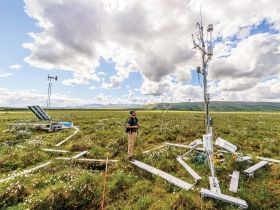Struggling to keep my balance, I teeter along a narrow plankway that wends through the rolling foothills near Denali National Park and Preserve. Just ahead, Northern Arizona University ecologist Ted Schuur, a lanky 6-footer, leads the way to Eight Mile Lake, his research field site since 2003. Occasionally I slip off the planks onto the squishy vegetative carpet below. The feathery mosses, sedges and diminutive shrubs that grow here—Labrador tea, low bush cranberry, bog rosemary—are well-adapted to wet, acidic soils.
Rounding the top of a knoll, we look down on an expanse of tundra that bristles with so many sensors and cables that it resembles an outdoor ICU ward. At the center of the site stands a gas-sensing tower that sniffs out the carbon dioxide drifting through the air from as far away as a quarter of a mile. At ground level, polycarbonate chambers placed atop the tundra whoosh as their tops periodically shut, then open, then shut again. Their job, I learn, is to trap the carbon dioxide rising from the surface and shunt it to an instrument that measures the amount.
The objective is to keep a running tally of CO2 as it’s inhaled and exhaled by plants and soil microbes, but not merely in the here and now. By artificially warming selected patches of tundra, Schuur’s open-air experiment aims to mimic the future, when air temperatures in Alaska are expected to be significantly higher. By 2100, the state is projected to see an additional warming of at least 4 to 5 degrees Fahrenheit over what’s already occurred, and that’s under the most optimistic scenario. Already, the tundra here is leaking carbon dioxide to the atmosphere, according to recent satellite-based measurements. The question Schuur is hoping to answer: As the region continues to warm, just how much more carbon dioxide will it contribute to the global pool?
Read more at Wired
Image: Ted Schuur with his permafrost research monitoring equipment at Eight Mile Lake study area, near Healey, Alaska. Schuur mimics conditions expected in the future to monitor how much carbon will be released in a warmer future Alaska. (Credit: Thomas Nash/High Country News)


